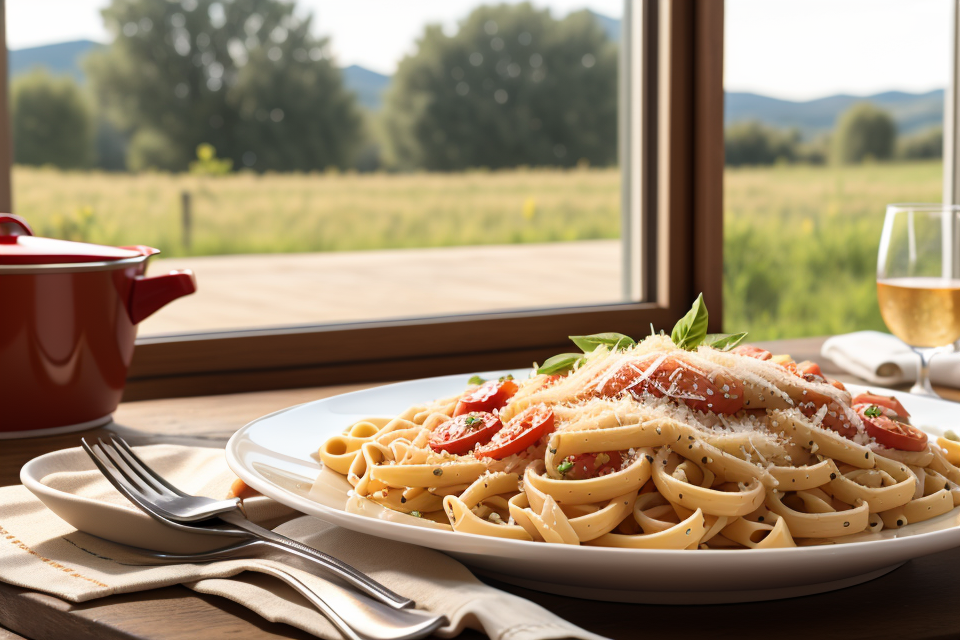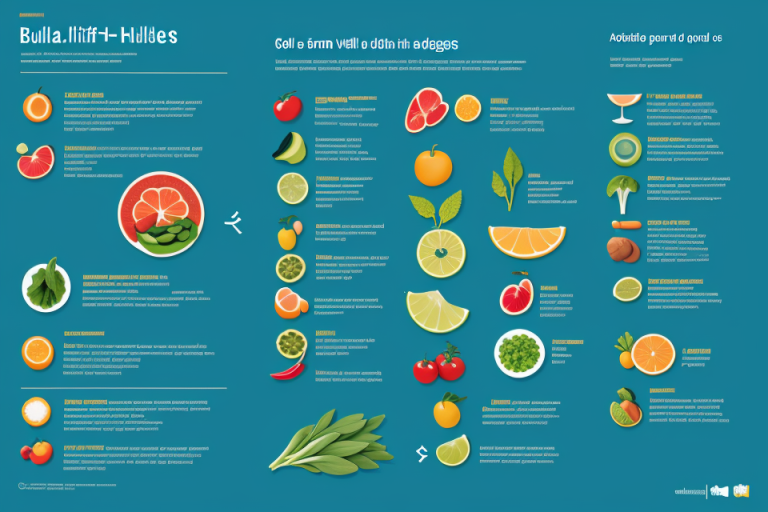Is Gluten-Free Pasta the Norm or the Exception? A Comprehensive Guide
Pasta is a staple food in many households, but for those with gluten intolerance or celiac disease, it can be a challenge to find gluten-free options that taste just as good. The question remains, are most pastas gluten-free? In this comprehensive guide, we will explore the world of gluten-free pasta and determine whether it’s the norm or the exception. We’ll take a closer look at the ingredients used in gluten-free pasta, the different types available, and the pros and cons of choosing gluten-free over traditional pasta. So, let’s dive in and find out if gluten-free pasta is the way forward or just a passing fad.
What is Gluten and Why is it Important to Know?
Gluten-Free Diet
Gluten is a protein found in grains such as wheat, barley, and rye. It is responsible for giving dough its elasticity and helps to create the characteristic chewy texture of baked goods. Gluten provides structure and helps food to hold together. For individuals with celiac disease, gluten triggers an immune response that damages the small intestine, leading to symptoms such as diarrhea, abdominal pain, and fatigue. A gluten-free diet is necessary for those with celiac disease to avoid these symptoms and prevent long-term health complications.
In recent years, there has been a growing trend towards gluten-free diets among individuals without celiac disease. Some claim that gluten-free diets can improve energy levels, boost weight loss, and even reduce inflammation. However, there is limited scientific evidence to support these claims, and many experts argue that a gluten-free diet should only be followed by those with celiac disease or a gluten intolerance.
A gluten-free diet involves avoiding all sources of gluten, including wheat, barley, and rye. This means giving up bread, pasta, cereal, and many processed foods that contain gluten. Gluten-free alternatives, such as gluten-free pasta, are becoming more widely available in supermarkets and specialty stores. However, it is important to note that many gluten-free products are highly processed and may contain high levels of added sugars and fats.
In summary, a gluten-free diet is necessary for individuals with celiac disease to avoid symptoms and long-term health complications. While some individuals without celiac disease may choose to follow a gluten-free diet, there is limited scientific evidence to support the health benefits of doing so.
Gluten Sensitivity and Intolerance
Gluten sensitivity and intolerance refer to a range of conditions that affect how the body responds to gluten, a protein found in wheat, barley, and rye. While some people may experience mild symptoms after consuming gluten, others may have more severe reactions that can significantly impact their quality of life.
Symptoms of Gluten Sensitivity and Intolerance
Some common symptoms of gluten sensitivity and intolerance include:
- Abdominal pain and discomfort
- Bloating and gas
- Diarrhea and constipation
- Fatigue and brain fog
- Skin rashes and itching
- Joint pain and inflammation
It’s important to note that not everyone with gluten sensitivity or intolerance will experience all of these symptoms, and some people may experience symptoms that are not listed here.
Causes of Gluten Sensitivity and Intolerance
Gluten sensitivity and intolerance can be caused by a variety of factors, including:
- Autoimmune disorders such as celiac disease
- Inflammatory bowel disease such as Crohn’s disease
- Irritable bowel syndrome (IBS)
- Food allergies or intolerances
- Gastrointestinal infections
- Inadequate digestion or absorption of nutrients
Diagnosis of Gluten Sensitivity and Intolerance
If you suspect that you may have gluten sensitivity or intolerance, it’s important to see a healthcare professional for proper diagnosis. There are several tests that can be used to diagnose gluten sensitivity and intolerance, including:
- Blood tests to measure antibodies to gluten
- Hydrogen breath tests to measure the absorption of gluten in the gut
- Genetic testing to identify genes associated with gluten sensitivity or intolerance
Treatment of Gluten Sensitivity and Intolerance
The treatment for gluten sensitivity and intolerance typically involves following a gluten-free diet. This means avoiding all sources of gluten, including wheat, barley, and rye, as well as any foods that may contain hidden sources of gluten such as modified food starch or maltodextrin.
In some cases, supplements or medications may be prescribed to help manage symptoms or improve gut health. It’s important to work with a healthcare professional to develop a personalized treatment plan that takes into account your individual needs and health history.
In conclusion, gluten sensitivity and intolerance are conditions that can have a significant impact on a person’s health and well-being. If you suspect that you may have gluten sensitivity or intolerance, it’s important to seek proper diagnosis and treatment from a healthcare professional.
Celiac Disease
Celiac disease is an autoimmune disorder that affects the small intestine. It is caused by a reaction to gluten, a protein found in wheat, barley, and rye. When someone with celiac disease consumes gluten, their immune system reacts by damaging the lining of the small intestine, leading to a range of symptoms and health problems.
Symptoms of celiac disease can vary widely and may include abdominal pain, diarrhea, bloating, weight loss, fatigue, and skin rash. In some cases, people with celiac disease may not experience any symptoms at all.
The only treatment for celiac disease is to follow a strict gluten-free diet. This means avoiding all foods that contain gluten, including many types of bread, pasta, cereal, and baked goods. For people with celiac disease, even small amounts of gluten can cause damage to the small intestine and lead to serious health problems over time.
It’s important to note that celiac disease is not a food allergy, but rather an autoimmune disorder. This means that it is caused by a problem with the immune system rather than a reaction to a specific food. While the exact cause of celiac disease is not fully understood, it is believed to be linked to a combination of genetic and environmental factors.
Overall, for people with celiac disease, it’s crucial to be aware of the presence of gluten in their diet and to take steps to avoid it in order to manage their symptoms and prevent long-term health problems.
The Science Behind Gluten-Free Pasta
Gluten-Free Flour Blends
Gluten-free pasta is a popular alternative to traditional wheat-based pasta, especially for individuals with celiac disease or gluten sensitivity. The key to making gluten-free pasta is to use gluten-free flour blends that can replicate the texture and taste of wheat-based pasta. In this section, we will explore the different types of gluten-free flour blends used in pasta making.
Types of Gluten-Free Flour Blends
- Rice Flour: Rice flour is a popular choice for gluten-free pasta as it is easy to digest and has a mild flavor. However, it can make the pasta crumbly and may not have the same elasticity as wheat-based pasta.
- Buckwheat Flour: Buckwheat flour is high in protein and has a nutty flavor. It can provide a better texture to gluten-free pasta than rice flour, but it may still be slightly more crumbly than traditional pasta.
- Potato Flour: Potato flour is another option for gluten-free pasta. It is high in starch and can help create a more elastic texture than rice or buckwheat flour. However, potato flour can be more expensive and may have a less appealing flavor.
- Almond Flour: Almond flour is a low-carb option for gluten-free pasta. It has a nutty flavor and can provide a good texture, but it is more expensive than other flours and may not be suitable for individuals with nut allergies.
- Bean Flours: Bean flours, such as chickpea flour or lentil flour, can also be used to make gluten-free pasta. They are high in protein and can provide a good texture, but they may have a stronger flavor than other flours.
Creating the Perfect Gluten-Free Pasta Dough
To create a gluten-free pasta dough that is similar to traditional pasta, it is important to use the right ratio of flour to liquid. Typically, a 1:1 ratio of flour to liquid is used, but this can vary depending on the type of flour used. Additionally, adding eggs to the dough can help create a more elastic texture. However, it is important to note that the egg should be cooked thoroughly to avoid foodborne illness.
In conclusion, there are many different types of gluten-free flour blends that can be used to make pasta. The right blend will depend on personal preference and dietary restrictions. However, with the right ingredients and techniques, it is possible to create a gluten-free pasta that is just as delicious and satisfying as traditional pasta.
Gluten-Free Pasta Production
The production of gluten-free pasta involves several key steps, from the selection of ingredients to the manufacturing process. In this section, we will explore the different methods used to produce gluten-free pasta and the challenges associated with each approach.
Ingredients Used in Gluten-Free Pasta Production
The primary ingredients used in gluten-free pasta production include rice flour, corn flour, quinoa flour, and potato starch. These ingredients are selected for their ability to create a dough that is similar in texture to traditional wheat-based pasta.
Rice flour is a popular choice for gluten-free pasta production due to its mild flavor and ability to create a smooth texture. Corn flour, on the other hand, has a slightly stronger flavor and can result in a slightly crunchier texture. Quinoa flour is also used in some gluten-free pasta production due to its high protein content and ability to create a firm texture.
Potato starch is another common ingredient used in gluten-free pasta production. It has a neutral flavor and is often used in combination with other flours to create a dough that is similar in texture to traditional wheat-based pasta.
Manufacturing Process of Gluten-Free Pasta
The manufacturing process of gluten-free pasta can vary depending on the specific ingredients used. In general, the process involves mixing the flour with water to create a dough, which is then extruded through a pasta machine to create the desired shape.
One challenge associated with gluten-free pasta production is ensuring that the dough holds together well during cooking. Gluten in wheat-based pasta helps to create a chewy texture and prevents the pasta from falling apart. In gluten-free pasta, this function is often replaced by eggs or specialized binders, which can affect the texture and flavor of the final product.
Another challenge associated with gluten-free pasta production is ensuring that the pasta is cooked evenly. Gluten-free pasta can be more susceptible to overcooking or undercooking, which can affect the texture and flavor of the final product. To address this issue, some manufacturers use specialized cooking techniques or additives to ensure that the pasta cooks evenly.
Overall, the production of gluten-free pasta is a complex process that requires careful attention to ingredient selection and manufacturing techniques. While gluten-free pasta is becoming increasingly popular, it remains a niche product that is often more expensive than traditional wheat-based pasta.
Nutritional Content of Gluten-Free Pasta
Gluten-free pasta is a popular alternative for individuals with celiac disease or gluten intolerance. While the taste and texture may differ from traditional pasta, the nutritional content is comparable. Here’s a breakdown of the key nutrients found in gluten-free pasta:
Carbohydrates
Gluten-free pasta is typically made from ingredients such as rice flour, corn flour, or potato starch, which provide complex carbohydrates. These carbohydrates are broken down slowly, allowing for a steady release of energy over time. This can help regulate blood sugar levels and promote feelings of fullness.
Protein
While gluten-free pasta may have slightly less protein than traditional pasta, it can still be a good source of this essential nutrient. Some brands of gluten-free pasta are fortified with additional protein sources, such as pea protein or rice protein, to boost the overall protein content.
Fiber
Gluten-free pasta may contain more fiber than traditional pasta, as many gluten-free flours are enriched with fiber. This can help support digestive health, regulate blood sugar levels, and promote feelings of fullness.
Micronutrients
Gluten-free pasta can be fortified with vitamins and minerals to ensure that it provides a balanced source of nutrients. Some brands add B vitamins, iron, and calcium to their gluten-free pasta to compensate for any deficiencies that may occur due to the absence of gluten.
Omega-3 Fatty Acids
Some gluten-free pasta brands add omega-3 fatty acids to their products, which can provide a range of health benefits, including reducing inflammation, supporting brain health, and promoting heart health.
Overall, gluten-free pasta can be a nutritious alternative to traditional pasta for individuals with celiac disease or gluten intolerance. While it may not be as abundant in certain nutrients as traditional pasta, it can still provide a balanced source of carbohydrates, protein, fiber, and other essential micronutrients.
Common Types of Gluten-Free Pasta
Brown Rice Pasta
Brown rice pasta is a popular gluten-free alternative to traditional wheat-based pasta. It is made from brown rice flour, which is rich in fiber and nutrients, and is a good source of manganese, phosphorus, and B vitamins. Brown rice pasta has a slightly nutty flavor and a chewy texture that is similar to traditional pasta.
One of the benefits of brown rice pasta is that it is easy to cook and can be used in a variety of dishes, including pasta salads, stir-fries, and casseroles. It is also versatile and can be used as a substitute for traditional pasta in most recipes.
However, it is important to note that brown rice pasta can be more expensive than traditional pasta and may not be as widely available in stores. Additionally, some people may find that brown rice pasta has a slightly different texture and flavor than traditional pasta, which may take some getting used to.
Overall, brown rice pasta is a healthy and tasty gluten-free alternative to traditional pasta that is worth considering for those with gluten sensitivity or intolerance.
Quinoa Pasta
Quinoa pasta is a popular gluten-free alternative to traditional wheat-based pasta. It is made from quinoa flour, which is derived from the quinoa grain. Quinoa is a pseudo-grain that is naturally gluten-free and has a high protein content, making it an ideal ingredient for gluten-free pasta.
Some of the benefits of quinoa pasta include:
- High protein content: Quinoa pasta is a good source of protein, with approximately 7 grams of protein per 100 grams of pasta. This makes it a great option for those who follow a vegetarian or vegan diet.
- High fiber content: Quinoa pasta is also high in fiber, with approximately 5 grams of fiber per 100 grams of pasta. This can help with digestion and satiety.
- Good source of essential amino acids: Quinoa pasta is a complete protein, meaning it contains all nine essential amino acids that the body cannot produce on its own. This makes it a great option for those who follow a plant-based diet.
- Versatile: Quinoa pasta can be used in a variety of dishes, from traditional pasta sauces to stir-fries and salads.
However, it is important to note that quinoa pasta can be more expensive than traditional wheat-based pasta and may not be as widely available in some areas. Additionally, some people may have an allergy or intolerance to quinoa, so it is important to read labels carefully and seek medical advice if necessary.
Buckwheat Pasta
Buckwheat pasta is a popular gluten-free alternative that is gaining popularity due to its unique taste and nutritional benefits. It is made from buckwheat flour, which is a type of flour that is gluten-free and high in protein, fiber, and antioxidants. Buckwheat pasta is a versatile ingredient that can be used in a variety of dishes, from simple pasta salads to more complex sauces and soups.
One of the advantages of buckwheat pasta is that it has a unique, nutty flavor that sets it apart from traditional wheat-based pasta. This flavor is due to the presence of buckwheat’s natural compounds, which are not found in wheat flour. Additionally, buckwheat pasta is low in calories and high in fiber, making it a healthy option for those who are looking to reduce their calorie intake or improve their digestive health.
Another advantage of buckwheat pasta is that it is easy to prepare. Unlike some other gluten-free pasta options, buckwheat pasta does not require any special preparation or cooking techniques. It can be cooked in the same way as traditional pasta, using the same cooking times and temperatures. This makes it a convenient option for those who are short on time or are new to cooking gluten-free meals.
Overall, buckwheat pasta is a delicious and nutritious gluten-free alternative that is worth considering for those who are looking to expand their pasta options. Its unique flavor and nutritional benefits make it a standout option among gluten-free pasta varieties.
Tapioca Pasta
Tapioca pasta is a popular alternative to traditional wheat-based pasta for individuals with gluten intolerance or celiac disease. It is made from a mixture of tapioca flour and water, which is then extruded through bronze dies to create the desired shape.
Advantages of Tapioca Pasta
- Gluten-free: Tapioca pasta is a great option for individuals who cannot consume gluten, as it is completely free of wheat, barley, and rye proteins.
- Easy to cook: Tapioca pasta has a slightly higher cooking temperature than traditional pasta, but it is generally easy to cook and does not require extensive preparation.
- Versatile: Tapioca pasta can be used in a variety of dishes, including sauces, salads, and soups, making it a versatile option for those who follow a gluten-free diet.
Disadvantages of Tapioca Pasta
- Texture: Tapioca pasta has a slightly different texture than traditional pasta, which may take some getting used to for those who are accustomed to the taste and feel of wheat-based pasta.
- Cost: Tapioca pasta can be more expensive than traditional pasta, as it is a specialty item that is not as widely available.
- Availability: Tapioca pasta may not be as widely available as traditional pasta, and it may be more difficult to find in some grocery stores or restaurants.
Overall, tapioca pasta is a popular option for individuals who follow a gluten-free diet and are looking for a versatile and easy-to-cook alternative to traditional pasta. While it may have some drawbacks, such as a slightly different texture and higher cost, it is a viable option for those who need to avoid gluten.
Is Most Pasta Gluten-Free?
Commercial Pasta Brands
Many commercial pasta brands market their products as gluten-free to cater to the growing demand for gluten-free options. However, it is essential to note that not all pasta brands are entirely gluten-free. The following are some examples of commercial pasta brands that offer gluten-free options:
- Buitoni: This brand offers a range of gluten-free pasta options, including penne, spaghetti, and lasagna. Their gluten-free pasta is made from a blend of rice flour, cornstarch, and potato starch.
- Barilla: Barilla is one of the most well-known pasta brands in the world. They offer a range of gluten-free pasta options, including spaghetti, penne, and fusilli. Their gluten-free pasta is made from a blend of rice flour, cornstarch, and quinoa.
- DeLallo: DeLallo offers a range of gluten-free pasta options, including spaghetti, penne, and macaroni. Their gluten-free pasta is made from a blend of brown rice flour and water.
- Garofalo: This brand offers a range of gluten-free pasta options, including spaghetti, penne, and fusilli. Their gluten-free pasta is made from a blend of corn flour and rice flour.
- Ronzani: Ronzani offers a range of gluten-free pasta options, including spaghetti, penne, and lasagna. Their gluten-free pasta is made from a blend of rice flour, cornstarch, and potato starch.
These are just a few examples of commercial pasta brands that offer gluten-free options. It is essential to read the labels carefully when purchasing pasta to ensure that it is gluten-free. Additionally, some gluten-free pasta brands may contain additives or preservatives, so it is crucial to choose brands that use natural ingredients and do not contain any harmful additives.
Homemade Pasta
While many individuals assume that gluten-free pasta is the norm, this is not necessarily the case. In fact, the majority of pasta products found in stores contain gluten, which is a protein found in wheat, barley, and rye. However, there is an exception to this rule: homemade pasta.
When it comes to homemade pasta, the decision to make it gluten-free is entirely up to the individual. Gluten-free flours, such as rice flour, corn flour, and almond flour, can be used to create a variety of delicious pasta dishes. Additionally, many recipes for homemade pasta call for eggs as a key ingredient, which can help to bind the dough together.
There are a number of benefits to making homemade gluten-free pasta. For one, it allows individuals to control the ingredients and avoid any potential allergens or intolerances. Additionally, homemade pasta is often fresher and more flavorful than store-bought pasta, as it is made with high-quality ingredients and has not been subjected to preservatives or other additives.
However, it is important to note that homemade gluten-free pasta is not always an easy feat. It can be challenging to achieve the right texture and consistency, and some individuals may find that their homemade pasta is too dense or crumbly. Additionally, homemade pasta requires a significant amount of time and effort to prepare, as it involves mixing, kneading, and rolling the dough by hand.
Overall, while homemade gluten-free pasta is an exception to the rule that most pasta contains gluten, it can be a great option for individuals who are looking to avoid gluten or other allergens. With the right ingredients and techniques, it is possible to create delicious and healthy homemade pasta dishes that are sure to please even the most discerning palate.
Tips for Enjoying Gluten-Free Pasta
Cooking Techniques
Cooking gluten-free pasta requires some special techniques to ensure that the pasta is cooked properly and doesn’t end up being too dry or too soggy. Here are some tips for cooking gluten-free pasta:
- Use a large pot of boiling water: Gluten-free pasta tends to be lighter and more delicate than regular pasta, so it can easily break or become overcooked if it’s not cooked properly. To avoid this, use a large pot of boiling water and add the pasta when the water is already boiling.
- Stir occasionally: Gluten-free pasta can stick to the bottom of the pot, so it’s important to stir it occasionally while it’s cooking. This will help prevent it from sticking and ensure that it cooks evenly.
- Cook al dente: Gluten-free pasta should be cooked al dente, which means it should still have a slight firmness when bitten. This will help prevent it from becoming too soft or mushy.
- Don’t overcook: Gluten-free pasta can become mushy if it’s overcooked, so it’s important to pay attention to the cooking time. Check the package instructions for recommended cooking times, and then check the pasta after a few minutes to ensure that it’s cooked to your liking.
- Drain thoroughly: Once the pasta is cooked, carefully pour it into a colander or strainer to drain the water. Make sure to shake off any excess water before using the pasta in your recipe.
By following these cooking techniques, you can ensure that your gluten-free pasta is cooked to perfection every time.
Pairing with Gluten-Free Sauces and Toppings
When it comes to enjoying gluten-free pasta, the key to a delicious meal is in the pairing. Here are some tips for selecting the perfect gluten-free sauces and toppings to complement your gluten-free pasta:
- Choose gluten-free pasta sauces: Many store-bought pasta sauces contain hidden sources of gluten, such as modified food starch or maltodextrin. To ensure a gluten-free meal, look for sauces labeled as gluten-free or make your own using gluten-free ingredients like tomatoes, garlic, and herbs.
- Experiment with gluten-free toppings: Gluten-free pasta doesn’t have to be a bland meal. Experiment with different gluten-free toppings like grilled chicken, sautéed vegetables, or fresh herbs to add flavor and texture to your dish.
- Avoid cross contamination: If you’re sensitive to gluten, it’s important to avoid cross contamination. Use separate cutting boards and utensils for gluten-free pasta and other dishes, and consider using a gluten-free flour for your toppings to prevent any accidental contamination.
- Don’t skimp on flavor: Just because gluten-free pasta is lower in gluten doesn’t mean it has to be flavorless. Experiment with different seasonings and spices to add depth and complexity to your dish. Consider using truffle oil, lemon zest, or Parmesan cheese to elevate the flavor of your gluten-free pasta.
By following these tips, you can enjoy a delicious and satisfying gluten-free pasta meal that won’t leave you feeling deprived.
Reading Food Labels
Understanding food labels is essential when it comes to making informed choices about the food you eat, especially when it comes to gluten-free pasta. Here are some tips for reading food labels when it comes to gluten-free pasta:
- Look for gluten-free certifications: When shopping for gluten-free pasta, look for products that have been certified as gluten-free by reputable organizations such as the Gluten-Free Certification Organization (GFCO) or the Celiac Sprue Association. These certifications provide assurance that the product meets strict standards for gluten-free content.
- Check the ingredient list: The ingredient list on the label should not include any sources of gluten, such as wheat, barley, or rye. Additionally, look for any additives or preservatives that may contain gluten, such as modified food starch or maltodextrin.
- Look for cross-contamination warnings: Some gluten-free pasta products may be processed on the same equipment as products containing gluten, which can lead to cross-contamination. Look for warnings on the label indicating that the product was processed in a gluten-free facility or that the manufacturer has taken steps to prevent cross-contamination.
- Be aware of hidden sources of gluten: Gluten is not just found in obvious sources like wheat, barley, and rye. It can also be found in unexpected sources such as modified food starch, maltodextrin, and some types of vegetable gums.
- Pay attention to serving sizes: Gluten-free pasta may have different cooking times and textures compared to regular pasta. Pay attention to the serving size on the label and follow the cooking instructions carefully to ensure that the pasta is cooked properly.
By paying attention to these tips when reading food labels, you can make informed choices about the gluten-free pasta you eat and ensure that you are getting a safe and enjoyable gluten-free meal.
Frequently Asked Questions about Gluten-Free Pasta
Can I eat regular pasta if I’m gluten-free?
It is essential to understand that people with celiac disease or gluten sensitivity must strictly avoid consuming gluten, which is a protein found in wheat, barley, and rye. Regular pasta, made from wheat flour, is not safe for individuals with gluten sensitivity or celiac disease to consume. Even a small amount of gluten can trigger an immune response in the body, leading to symptoms such as abdominal pain, diarrhea, and fatigue.
Therefore, individuals with gluten sensitivity or celiac disease must opt for gluten-free pasta alternatives, which are made from rice, corn, or other gluten-free flours. These alternatives provide a similar texture and taste to regular pasta but without the harmful effects of gluten. It is important to note that even though gluten-free pasta is a safe option for individuals with gluten sensitivity or celiac disease, it is not recommended to consume it regularly if you do not have any gluten-related health issues.
In summary, individuals with gluten sensitivity or celiac disease must avoid regular pasta and opt for gluten-free alternatives to ensure their health and well-being.
Can I substitute gluten-free flour for regular flour in my recipes?
Substituting gluten-free flour for regular flour in recipes is a common question among home cooks and bakers. The answer is yes, you can substitute gluten-free flour for regular flour in many recipes, but there are a few things to keep in mind.
Firstly, gluten-free flours are typically made from alternative grains such as rice, corn, and potato, and they behave differently than wheat flour. This means that the texture and consistency of the final product may be different when using gluten-free flour. For example, gluten-free pasta may be less elastic and have a different mouthfeel compared to regular pasta.
Additionally, the ratio of water to flour may need to be adjusted when using gluten-free flour. Gluten-free flours tend to absorb more water than wheat flour, so it’s important to start with a smaller amount of water and gradually add more until the desired consistency is reached. Over-mixing gluten-free dough can lead to toughness, so it’s important to mix just until the dough comes together.
It’s also worth noting that not all gluten-free flours are created equal. Some brands may have added starches or thickeners to improve texture, while others may be more powdery and require more moisture. It’s important to experiment with different brands and types of gluten-free flour to find the one that works best for your recipe.
In conclusion, while it is possible to substitute gluten-free flour for regular flour in many recipes, it’s important to keep in mind the differences in behavior and adjust the recipe accordingly. With some experimentation and patience, you can create delicious gluten-free pasta dishes that are just as satisfying as their wheat-based counterparts.
Is gluten-free pasta more expensive than regular pasta?
While gluten-free pasta is becoming increasingly popular, many people wonder if it is more expensive than regular pasta. The answer to this question depends on several factors, including the type of pasta, the brand, and the location where it is purchased. In general, gluten-free pasta tends to be more expensive than regular pasta due to the additional costs associated with production and packaging.
- Production Costs: Gluten-free pasta is typically made from alternative flours, such as rice flour, corn flour, or potato starch, which can be more expensive than wheat flour. Additionally, the production process for gluten-free pasta may require additional steps, such as mixing with binding agents or undergoing additional processing to ensure that the pasta has the correct texture and taste. These additional steps can increase the cost of production.
- Packaging Costs: Gluten-free pasta often requires special packaging to prevent cross-contamination with gluten-containing products. This can include separate production lines, dedicated equipment, and specially designed packaging materials. These additional packaging costs can contribute to the higher price of gluten-free pasta.
- Limited Availability: Gluten-free pasta may not be as widely available as regular pasta, which can affect its price. Since it is not as common, there may be less competition among brands, leading to higher prices. Additionally, it may be more difficult to transport gluten-free pasta, which can also contribute to its higher cost.
Despite the higher cost, many people choose to purchase gluten-free pasta due to medical reasons or dietary preferences. While it may be more expensive than regular pasta, it is important to consider the potential health benefits and personal preferences when making a decision.
Can I make my own gluten-free pasta?
Yes, you can make your own gluten-free pasta! Here are some steps to get you started:
Ingredients:
- 2 cups all-purpose flour (gluten-free)
- 2 eggs
- 2 tablespoons olive oil
- 1 teaspoon salt
- Water
Instructions:
- In a large mixing bowl, combine the flour and salt.
- Create a well in the center of the mixture and add the eggs and olive oil.
- Mix the ingredients together until a dough forms.
- Knead the dough for 5-10 minutes until it becomes smooth and elastic.
- Let the dough rest for 30 minutes.
- Roll out the dough to your desired thickness.
- Cut the dough into your desired shape.
- Cook the pasta in a large pot of boiling salted water for 2-3 minutes or until al dente.
- Drain and serve immediately.
Note: You can experiment with different flours and ingredients to find the perfect gluten-free pasta recipe for you.
FAQs
1. What is gluten and why is it commonly found in pasta?
Gluten is a type of protein found in certain grains, most notably wheat, barley, and rye. It gives elasticity and chewiness to baked goods and pasta, and helps to create the characteristic texture of these foods. Many types of pasta, including spaghetti, penne, and lasagna, are made from wheat flour, which contains gluten.
2. What is gluten-free pasta and why is it needed?
Gluten-free pasta is made from a combination of rice flour, corn flour, and other grains that do not contain gluten. It is needed for people who have celiac disease or gluten intolerance, as gluten can cause inflammation and damage to the small intestine in these individuals. Gluten-free pasta is also popular among people who follow a gluten-free diet for other reasons, such as weight loss or general health concerns.
3. Is gluten-free pasta easy to find?
Gluten-free pasta is becoming increasingly easy to find in most supermarkets and health food stores. It is often found in the same aisle as regular pasta, but in a separate section or with a different label. Some specialty stores may also carry a wider variety of gluten-free pasta options, including organic and non-GMO varieties.
4. How does gluten-free pasta compare to regular pasta in terms of taste and texture?
Gluten-free pasta can have a slightly different taste and texture compared to regular pasta. Some people find that gluten-free pasta has a slightly nuttier or sweeter flavor, while others may notice a difference in the texture. However, many brands of gluten-free pasta are designed to mimic the taste and texture of regular pasta as closely as possible, and some people find them indistinguishable from regular pasta.
5. Is gluten-free pasta more expensive than regular pasta?
Gluten-free pasta can be more expensive than regular pasta, but the price has been coming down in recent years. This is due to increased demand and competition in the market, as well as improvements in manufacturing processes. However, the price can still vary depending on the brand and the type of gluten-free pasta. Some specialty or organic brands may be more expensive than regular pasta, but they may also offer a wider variety of flavors and ingredients.
6. Can I substitute gluten-free pasta for regular pasta in recipes?
In most cases, gluten-free pasta can be substituted for regular pasta in recipes. However, it is important to note that gluten-free pasta may have a slightly different cooking time and may not have the same texture as regular pasta. It is a good idea to start with a small batch of gluten-free pasta to see how it performs in a recipe before using it in a larger quantity.
7. Is all pasta gluten-free?
No, not all pasta is gluten-free. Regular pasta is made from wheat flour, which contains gluten. However, many brands now offer gluten-free pasta options that are made from a combination of rice flour, corn flour, and other grains that do not contain gluten. It is important to read the label carefully to ensure that the pasta is gluten-free if you have celiac disease or gluten intolerance.







